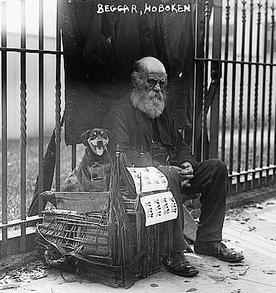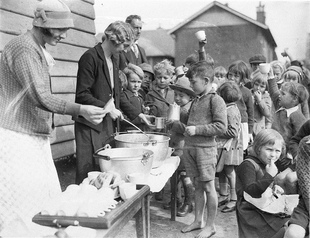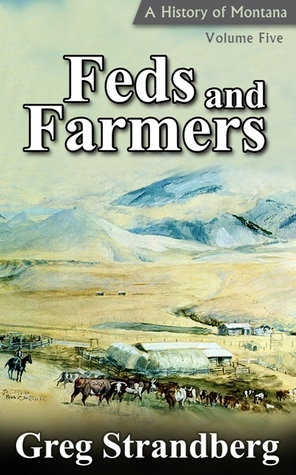
In 1929 GDP had been $104 billion but by 1932 it was down to $58.5 billion, a 43% drop. Steel plants were operating at one-eighth of their capacity while some cities saw 80% of their workforce unemployed.
No one really knew how many people were out of work – it was impossible to tell, so immense was the unemployment problem. It’s now figured than 12 million people were out of work in those early years of the depression, 25% of the country. In 1932 the American Federation of Labor estimated that just 10% of people were actually working full-time.
Another 2 million people were homeless. Home foreclosures were a national disaster. Usually the country could expect 78,000 people to get behind on their mortgages each year, resulting in foreclosures by the banks. By 1932, however, there were 273,000 foreclosures, and by 1933 it was 1,000 a day.
One New York judged saw 425 evictions in one day. People either lived on the streets or found room with friends and relatives. They doubled up, “or even tripled up,” historian Edward Ellis tells us, “until ten or twelve people were crammed into three or four rooms.”
More than 6 million people were 65 or older in 1929, yet no social supports existed for them at all. About half the states in the country had old age pensions at that time, and most gave $15 a month. If they didn’t have family and they couldn’t work, they truly were at the mercy of the elements.
Hoovervilles sprouted up, “ramshackle communities of hastily-thrown-together shacks” that “housed thousands of homeless, jobless, moneyless men.” The largest was Hoover Valley, so named because it was located on an old reservoir bed in New York City’s Central Park. In September 1932 the police raided it and “arrested twenty-five men on charges of vagrancy.”
That attitude was common, to persecute the unfortunate victims of the rich man’s greed. Often people were blamed for their plight, with no consideration given to the massive Wall Street speculation that had caused the mess.
Henry Ford said that these unemployed men didn’t want to work even at a time when he was laying off workers in droves. In 1919 Ford Motor Company had had 128,000 employees but by 1931 that number had been cut by 345%, to 37,000.
The textile industry took it real hard, and by 1930 “half the 280,000 textile mill workers in New England were out of work.” Former president Calvin Coolidge said “the final solution of unemployment is work.”
That didn’t do much to assuage the despair that was fast taking over the country. In Pennsylvania a study found that the average unemployed person was “thirty-six years old, native-born, physically fit, and with a good previous work record.”
That study was a bit lopsided, with just over 30,000 people sampled. Historian Edward R. Ellis paints it a little differently. “Negroes and aliens were the last hired and the first fired,” he says. “Young men and women were graduated from high schools and colleges into a world without jobs.”
That was something that wasn’t much discussed much, the 25% of teens and young men in their early-20s who had never had a job. All in all, this demographic represented a third of the unemployed.
Adding insult to injury, when employers began hiring again, it was the older and experienced workers that were typically chosen. For those Americans that had been born in the 1910s, a life of hardship and misery were about all one had to look forward to.
In Mississippi the governor said the nation’s unemployment problem would go away tomorrow should the country simply ship 12 million blacks back to Africa. Spanish-American War veterans said much the same about the nation’s 10 million aliens, even though there were only 6 million of them.
The government didn’t need to ship people out, however – they were leaving willingly. U.S. Census projections had estimated the population in 1940 would be 141 million.
When that year came around, however, just 132 million people called American home. Accounting for accepted migration patterns, it’s estimated that as many as 7.3 million people may have left the country, the only time in the nation’s history that the population actually declined from one Census to the next.
Many were going back to Europe, others to the Soviet Union. In just the first eight months of 1931, more than 100,000 people put in applications for emigration to the Soviet Union.
 Children's soup line
Children's soup line
Fuel was in the air though with gas stations doing a thriving business as “Americans drove their battered family cars here and there in endless quest for work.” Family life wasn’t just affected, it many instances it failed to take root for a new generation. “It has been estimated that the Depression postponed 800,000 marriages,” Ellis says.
Many could survive on nothing but scraps they’d find in the garbage. A photograph of President Hoover feeding his dog on the White House lawn elicited much outcry from starving Americans.
It was reported in 1933 by the Children’s Bureau that 20% of kids weren’t eating enough to get the kinds of nutrition their bodies needed to grow.
One teacher asked a student if she was ill and the student said she was just hungry. The teacher urged her to go home and eat but the girl said, “I can’t. This is my sister’s day to eat.”
Congress figured it’d take a Native American $0.11 a day to be fed, while a textile factory owner figured the sum for his workers was $0.06 a day.
Gardening exploded as people sought ways to eat without the need of money. In New York in 1933 there were 65,000 gardens tended by the unemployed.
Practicality was a large part of it. Sales of "glass jars for home canning of fruits and vegetables were the highest in the decade,” Boardman tells us. Henry Ford made it a rule that all his workers had a garden, and if they had no room of their own, they’d tend a section on his vast 4,000 acres.
Gardening was at least something to keep people busy, some form of work to keep them from idleness. Even those that had work, however, weren’t always paid.
Chicago teachers were indicative of the pains most in the nation were facing. The city “cut its teaching rolls by 1,000, and those who still had jobs were unpaid for a year or more.” Perhaps a bit odd today, enrollment in high school went up. As historian Foy Boardman explains, “many young people who would otherwise have left school for a job decided they might as well stay in school since there were no jobs.”
Colleges were hit particularly hard, even though “$1,000 would cover a year’s expenses at an Ivy League college.” The thing was, no one had the money. Milk was $0.10 a quart in 1933, bread $0.07 a loaf. Butter went for $0.23 a pound and a dozen eggs could be had for $0.20. Most people couldn’t afford any of that.
“In the timberlands of the Great Northwest,” Ellis tells us, “some desperate men set forest fires so that they would be hired to extinguish them.”
Times were tough, miserable, and without hope. Hope was coming, however, and in a manner few could expect.
Notes
Boardman, Fon W. Jr. The Thirties: American and the Great Depression. Henry Z. Walck, Inc.: New York, 1967. p 45, 57-8, 61, 87, 135.
Ellis, Edward Robb. A Nation in Torment: The Great American Depression, 1929-1939. Kodansha America: New York, 1970. p 231-45.
Zinn, Howard. The Twentieth Century: A People’s History. Harper Perennial: New York, 1980. p 111-2.


